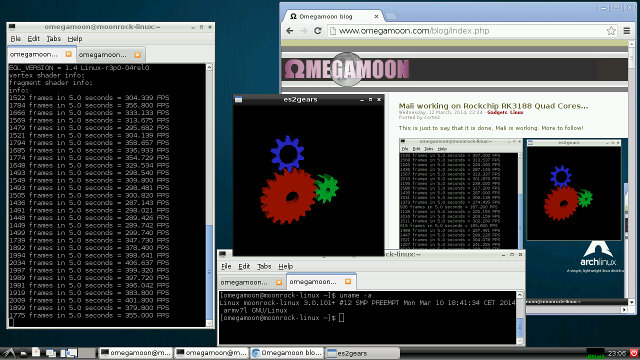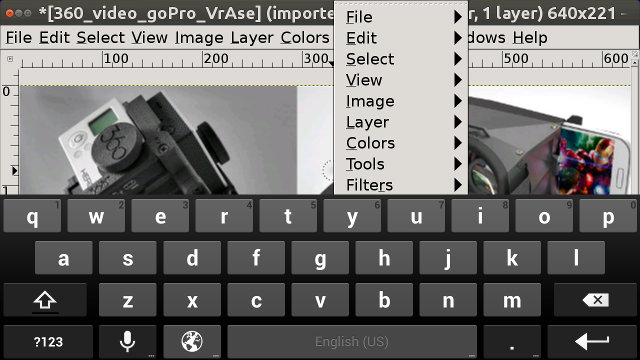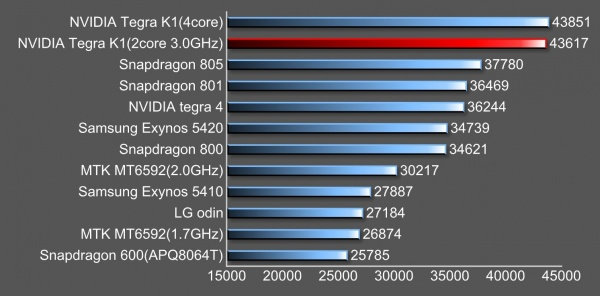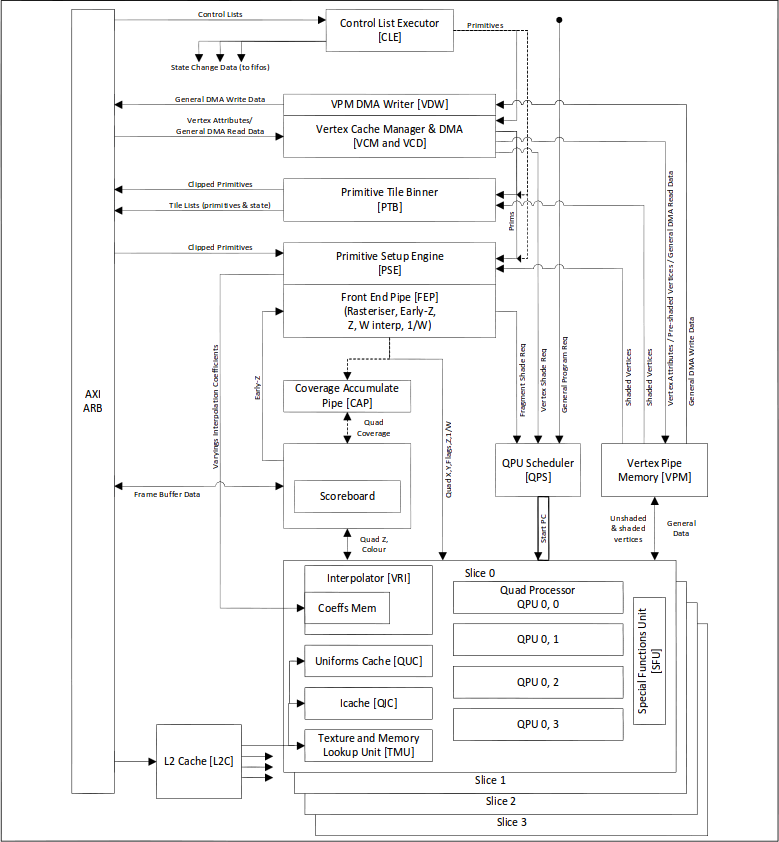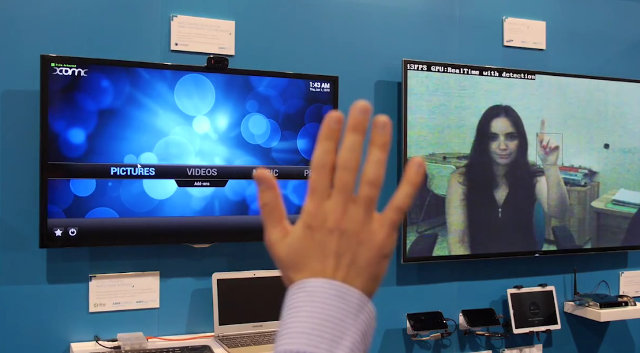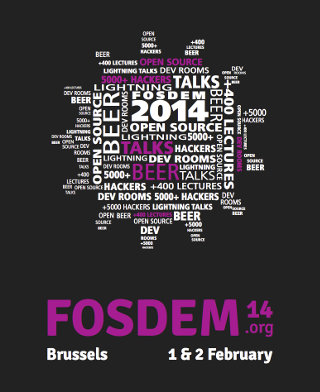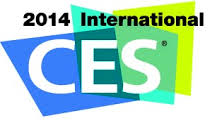Accelerated 3D graphics in Linux with Mali-400 via OpenGL ES has been possible for nearly a year on RK3066 devices, but there was no such support for RK3188. This week however, both Naoki FUKAUMI and omegamoon have reported OpenGL ES to work in in their respective RK3188 devices. I don’t know which device omegamoon used, but Naoki did so in Radxa Rock, and even posted instructions to build it yourself. They’ve mostly followed the work done by olegk0 for Rockchip, and Mali drivers build instructions provided in linux-sunxi community, and it can be summarize in 3 main steps: Cross-compile drm.ko, mali_drm.ko, ump.ko, mali.ko in a Linux machine Copy and load the four modules to your RK3188 based board or device. Install dependencies and binary Mali drivers from sunxi-linux in your Rockchip device Once this is done you can try some OpenGL ES demos such as esgears2 or glmark2-es to test […]
Xserver XSDL X Window Server for Android Allows You to Run Linux Apps in Android
It has been feasible to run Linux apps in Android by installing a Linux distribution in a chroot using some app such as Complete Linux Installer, and accessing the graphical application via VNC. I tested this solution with Ubuntu in Android using ODROID-X development board, and it worked fine, except the performance was rather poor. There’s now another solution with XServer XSDL app, X Window System server for Android, that can be used to stream application from a Linux PC or to launch app from a Linux distribution installed in your Android device. I’ve given a quick try in my Android phone, and after installing and running the app, it will give instructions to launch gimp in your Linux PC to use it in the phone: Launch these commands on your Linux PC env DISPLAY=192.168.0.100:0 metacity & env DISPLAY=192.168.0.100:0 gimp Just type this command line into a terminal, and gimp […]
Nvidia Tegra K1 32-bit and 64-bit Benchmarked with Antutu
Nvidia announced their latest Tegra applications processors at CES 2014 with the Tegra K1 32-bit and 64-bit ARM SoCs, as well as Tegra K1 MVC for automotive application. The 32-bit version comes with four Cortex A15 cores up to 2.3 GHz plus a companion core, and the 64-bit version with 2 ARMv8 cores (Cortex A53?) clocked up to 3 GHz. Both SoC features a 192-core Kepler GPU, and we’ve been shown some high-end graphics demo (OpenGL, OpenGL ES, OpenCL…) with in the reference tablet. Some charts has surface showing both 32- and 64-bit Tegra K1 scoring well over 40,000 and with an excellent 3D graphics score. The benchmark was run in reference platform with 32-bit or 64-bit Tegra K1, as well as the Tegra Note P1761 tablet with a 32-bit quad core Tegra K1 processor apparently clocked at a lower frequency, and with a not-that-good flash. The dual core, 64-bit […]
Raspberry Pi Gets Open Source 3D Graphics Drivers and Documentation
The Raspberry Pi was launched 2 years ago, and for its birthday, Broadcom decided to release documentation and open source OpenGL ES 1.1 and 2.0 driver for the Videocore IV GPU. You may remember the Raspberry Pi Foundation already release an open source GPU driver in 2012, but this was only for the part running on the ARM11 core for Broadcom BCM2835 SoC, which is just a few hundred lines of code long, and communicates with a binary blob which does all the work in the GPU itself. This new release however goes much further with a 111 page document entitled “VideoCore IV 3D Architecture Reference Guide“, and open source driver for the 3D System of the GPU. Strangely the release is however not for BCM2835, but instead BCM21553. Broadcom clearly has the source for BCM2835 too, so this must have been made for legal reasons. VideoCoreIV packs a lot […]
ARM Mali GPU Demos at CES 2014 – 4K 3D UI and Games, ASTC Texture Compression, XBMC + Gesture Recognition, and HEVC Video Decoding
Phill Smith, Demo Manager at ARM, has filmed and uploaded four very interesting demos of what new features will be possible thanks to new generation ARM Mali-450 and Mali-T6xx GPUs including 4K 3D user interfaces and games, ASTC texture compression, and OpenCL accelerated gesture recognition and HEVC / H.265 video decoding. 4K Resolution 3D User Interface and Game Demo The first demo showcases a Geniatech box (ATV1800?) powered by AMLogic AML8726-M8 featuring an ARM Mali-450MP6 GPU running Android with a user 4K 3D interface designed by Autodesk using Scaleform UI. The rest of the video shows Timbuku 3D gaming demo running at 3840×2160 (4K2K) @ 24 fps. The frame rate appears to be low, but that’s because the box is using HDMI 1.4, which limits UHD output to 24fps. 2160p60 is only available via HDMI 2.0. ASTC Compression Demo on Samsung Galaxy Note 3 3D Textures are getting bigger and […]
FOSDEM 2014 Schedule and A Selection of Sessions
It’s soon time for FOSDEM 2014, a 2-day event where thousands members of the open source communities meet, share ideas and collaborate. Like the other years, it’s free to attend, and there’s no registration, and this year, FOSDEM 2014 will take place on February 1-2 in Brussels. There are 8 main tracks: Tracing and debugging Memory and storage IPv6 Mail Mathematics Hardware Miscellaneous Security FOSDEM 2013 had 7 tracks, but most topics changed with only Security and Miscellaneous tracks featured in the 2014 edition. There will also be four keynotes and devrooms for a total of 464 sessions (vs. 488 last year). Developers rooms that may particularly be of interest to readers of this blog are: Energy-efficient computing devroom – e.g. energy scavenging, battery life improvements, power measurements in embedded systems, open source power measurement tools and low power devices, etc… Internet of things devroom – 6LoPWAN, LTE in Linux, […]
CES 2014 Keynotes and Linux Conference Australia 2014 Videos
The Consumer Electronics Show and LinuxConf Australia are completely different events, the former targets consumers and takes place in the US, and the latter is for Linux users, developers & systems administrators, and occurs in Australia. However, both happened at the same time this year, and video recording for CES 2014 keynotes, and LinuxConf Australia 2014 (LCA 2014) sessions for both events are now available. CES 2014 Keynote videos While the event took place, it was quite difficult, and sometimes just impossible, to find videos of the keynotes, either live or recordings, and I could only watch Intel, Nvidia, Samsung, and Sony keynotes at the time. I’ve been informed that at least some of CES 2014 keynote videos are now available online. I can access 9 videos from Intel, Yahoo, Audi, Cisco, Sony, etc… Thanks to Csilie for the link. Linux Conference Australia 2014 LCA 2014 took place on […]
Imagination Unveils OpenGL ES 3.0 Compliant Entry Level PowerVR Series6XE GPUs, and Series6XT Architecture Promising TFLOPS Performance
Imagination Technologies has announced four OpenGL ES 3.0 compliant mobile GPUs based on PowerVR Series6XE Rogue architecture for entry level ($100) smartphones, tablets, and other low-end consumer devices such as wearables and smart TVs, as well as four high-end GPUs based on PowerVR Series6XT Rogue architecture capable of TeraFLOPS computing power. PowerVR Series6XE GPUs The new PowerVR Rogue GPUs will deliver the same fillrate performance as equivalent Series5XT multi-processor configurations but offer more in terms of features and functionality, including OpenGL ES 3.0, OpenCL 1.x, and DirectX 9.3. Four entry-level GPUs have been introduced at CES 2014: PowerVR G6050 – Smallest fully-featured GPU core by Imagination with support for OpenGL ES3.0 and OpenCL 1.x. PowerVR G6060 – Same as G6050, but adds PVRIC2, the company’s second generation lossless PowerVR Image Compression. It reduces bandwidth requirements, and it likely to be used in entry-level tablets, HD TVs and STBs. PowerVR G6100 […]


